The MSI Titan GT77 Review: Desktop-Class Core i9-12900HX Tested
by Brett Howse on September 1, 2022 10:00 AM EST- Posted in
- Laptops
- Intel
- MSI
- Alder Lake
- Alder Lake-HX
System Performance
The Intel HX platform really is a big departure from what the company previous offered in the notebook space. The Core i9-12900HX desktop-class processor offers several advantages over the more traditional H-Series Alder Lake such as what is found in the MSI Raider GE76. An additional two P-cores add four more high performance threads, bumping this device to an impressive 24 threads. And unsurprisingly, Intel has also bumped the power levels available to support the additional P-Cores. Possibly the biggest difference though is that the HX-series supports two DIMMs per channel of memory, which allows the Titan GT77 to support up to 128 GB of system RAM. If you need to run memory-intensive workloads such as virtual machines, that is a big jump from the 64 GB limit on Alder Lake H platforms.
As previously mentioned, the move to packaging a desktop processor into a notebook form factor does have some drawbacks for Intel. With Alder Lake-H, Intel had finally integrated the PCH into the processor package, meaning the newest H-Series platforms are a single-chip design. The HX takes a step back here since on the desktop, PCH is still a separate entity, meaning Intel has moved back to a two-chip solution for the complete HX platform. For the end user that is not a big deal, but it does require extra work from the laptop motherboard designers, along with the extra traces needed for two more RAM slots.
The review unit shipped with four 16 GB DDR5-4000 sticks for a total of 64GB of RAM in a 2DPC configuration.
Comparing the Core i9-12900HX with the Core i9-12900HK, both have the same maximum boost frequency of 5.0 GHz, but the HX offers an additional two P-Cores adding four threads. And unsurprisingly, it has a higher power limit as well. So for single-threaded tasks they should be very similar, but for multitasking or multithreaded workloads, the HX should have a significant advantage.
The negative for the HX-Series compared to the regular H-class processors is in the graphics department. The desktop processors do not get access to Intel’s fastest 96 Execution Unit Iris Xe graphics configurations, and have to make due with the more basic 32 EU UHD configuration. That being said, the high-end nature of the HX platform is such that the CPU is likely always going to be paired with discrete graphics anyway. MSI supports a Hybrid graphics mode which is NVIDIA’s Optimus graphics switching, or you can run in discrete mode which bypasses the integrated graphics altogether. If you do the latter, Thunderbolt video-out is unavailable.
Cooling is always critical in a notebook design, and over the last several years both Intel and AMD have more or less done away with what we'd consider traditional Thermal Design Power (TDP) designations. Both companies still have an official TDP value, but both allow their chips to be run at a much higher power draw if the laptop designers can accommodate that extra heat. The “base” power for the Core i9-12900HX is now 55 Watts, with a peak power draw of 157 Watts. The base is 10 Watts higher than the normal H-Series, and 42 Watts higher on the peak. Later in the review we will go over the power levels that MSI has decided upon for their various performance modes for the Titan GT77.
To see how the MSI Titan GT77 performs, we have run it through our notebook workflow. Comparisons will be to other high-performance notebooks. If you would like to compare the Titan GT77 to any device we’ve tested, please use our online Bench tool.
PCMark 10
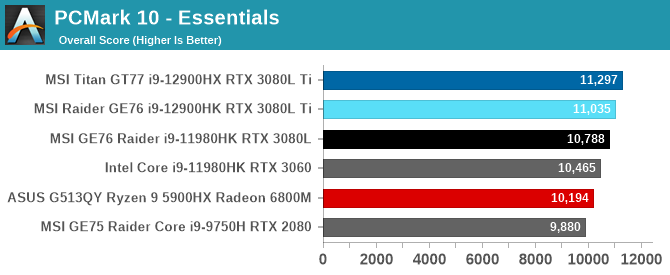
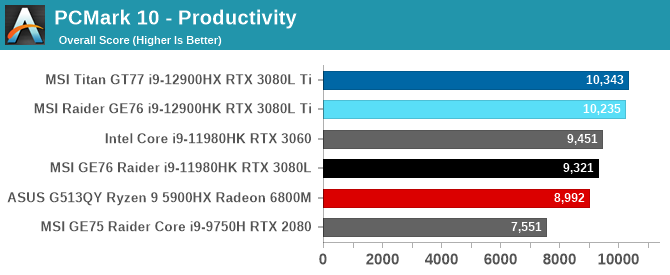
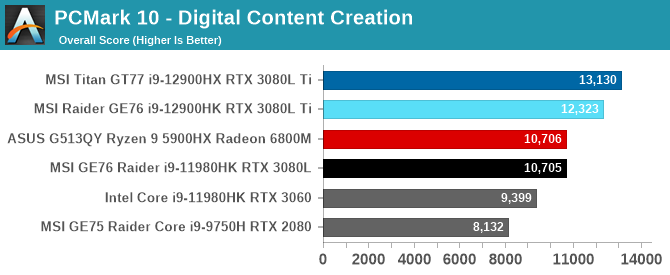
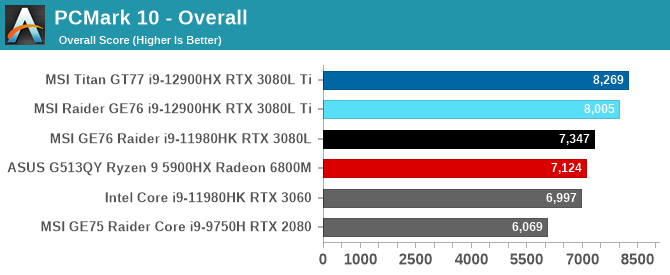
UL’s PCMark suite tests all aspects of a device including CPU, GPU, memory, storage, and more. Although the Raider GE76 and Titan GT77 both have the same NVIDIA RTX 3080L Ti GPU, the HX processor in the Titan lets it pull away here.
Cinebench R20
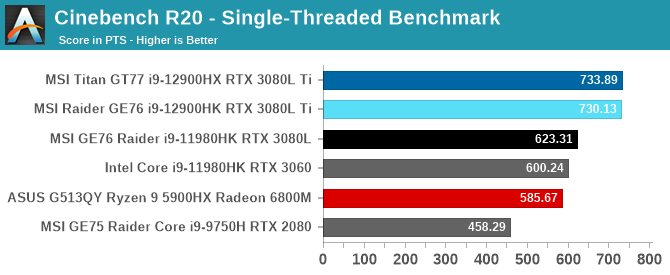
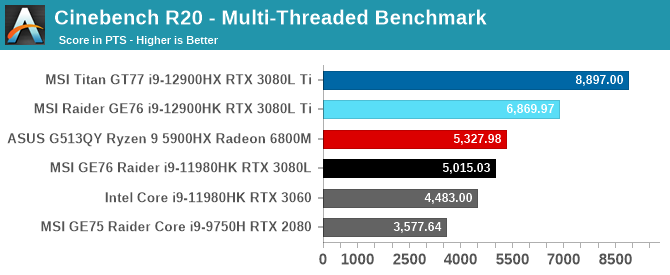
As a purely CPU-bound task, Cinebench is a nice tool to gauge single-threaded and multi-threaded performance. In the single-threaded test, perhaps unsurprisingly the two Alder Lake processors are within the margin of error, but the two additional P-Cores found in the HX one really lets it pull ahead in the multiheaded result.
Handbrake

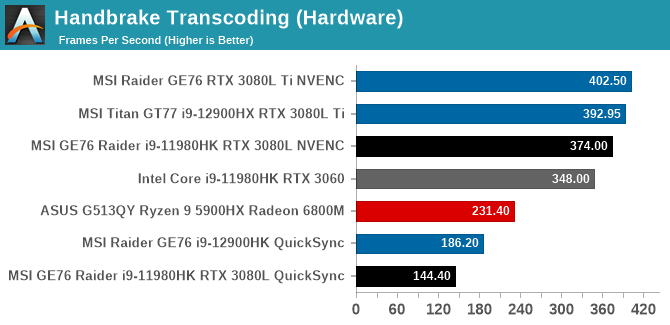
The popular transcoding tool Handbrake is a multithreaded workload, and it also allows you to do the transcode in either software or hardware. Generally, software encoding yields a better result all things else being equal, and hardware encoding is generally faster and more energy efficient.
In the software results, the MSI Titan GT77 wins by a good margin with the more powerful i9-12900HX processor. In the hardware results, the RTX 3080L Ti is very potent.
7-Zip

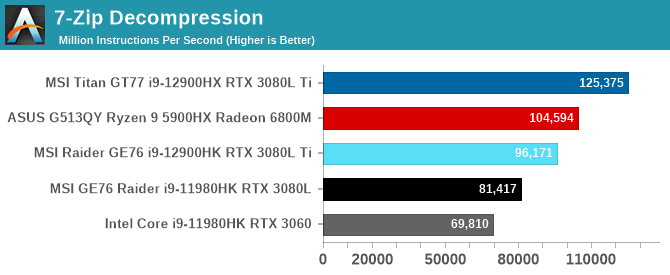
The open source file compression utility has an internal benchmark which allows you to measure compression and decompression performance. Intel has had an edge in compression for some time, and the latest HX processor leaves everything else in the dust. On the decompression results AMD’s Ryzen 5000 series platform is very strong, but the brute force of additional P-Cores and power let the HX win here too.
Web Tests
Web performance is not only CPU bound, but also bound by the web browser itself. For consistency, all tests are done in the built-in Microsoft Edge browser which is based on the Chromium project. As browsers get updated, results can be impacted, and we see that here today. The results we provide are a point in time of when the original laptop was reviewed, so performance changes from the browser can make a big impact.

In the Speedometer 2.0 benchmark, the Titan GT77 is at the bottom of the pack due to the normal browser updates that occur. Microsoft Edge has regressed in performance at least in terms of DOM API usage.

On WebXPRT 3 we see a more familiar bar graph with the Titan GT77 on top. Principled Technologies has recently released WebXPRT 4, and while we don’t have the data from the other device for that benchmark, the Titan GT77 achieved a score of 288.


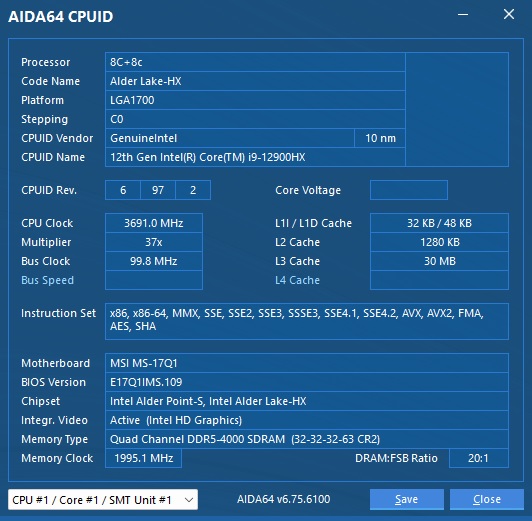








25 Comments
View All Comments
Otritus - Sunday, September 4, 2022 - link
It’s a pretty decent benchmark to measure relative perform between processors, but almost no software uses the engine making it not “real world”. Cinebench is not a very good predictor for gaming performance because it scales poorly with additional cache. It is a decent predictor of productivity differences since it is a rendering workload, but you can always use “real world” tests like blender or adobe. I wouldn’t say it’s terrible — as it can provide decent insight into a processor with a single benchmark — but it provides no insight into workloads that a micro architecture can be very good at.bogda - Friday, September 2, 2022 - link
I expected at least several pictures of laptop internals. Considering the type of laptop tested, this would probably be interesting for many anandtech readers.Ryan Smith - Friday, September 2, 2022 - link
Unfortunately, we are typically prohibited from disassembling laptops these days. The manufacturers like to get them back intact.bogda - Friday, September 2, 2022 - link
I am sure anandtech with its reputation and history can get a permission to open and close desktop replacement laptop from manufacturer without problems. Peek inside it the least you readers expect.PeachNCream - Saturday, September 3, 2022 - link
No they really can't do that if they expect to get more review samples in the future. Reviewer sites of yore used to buy their hardware off the shelf, but in a age where landing benchmarks first is going to generate competitive page views, reviewers can't realistically wait until a laptop/phone/desktop lands on the shelves (especially now with supply problems, scalpers, and gray market reseller markups) so this is the world we live in. If you want internals, you just have to wait until someone rips one apart and that probably won't be very early in the hardware life cycle.IBM760XL - Friday, September 2, 2022 - link
Does AnandTech typically return laptops not-intact? :)It's a fair request, one of the things I look for in laptops is upgradeability. Being able to add more RAM or storage or perhaps upgrading the WiFi card down the road is an important consideration.
Although as an owner of an MSI, I'm well aware of their "opening this area voids the warranty" sticker. Not that it's ever stopped me, but they seem to be more of a stickler for that than most.
sheh - Friday, September 2, 2022 - link
Why are bad keyboard layouts the norm?Plenty of unused space horizontally (and also vertically).
meacupla - Friday, September 2, 2022 - link
What are you talking about? The keyboard layout is fineThe sides are filled with speakers, the rear is filled with cooling, and the front has a giant track pad.
IBM760XL - Friday, September 2, 2022 - link
My guess is sheh prefers full-width NumPads?Personally I have fewer complaints than for most laptop keyboards. It doesn't have half-height arrow keys, which is my top requirement (although it's not quite full-size, let's give it a B grade). The Cherry MX probably hash decent key feel/travel, which is also lacking on some laptops.
I'd personally slightly prefer dedicated page up/down/home/end buttons, versus the NumPad-off variant, but that's a small quibble and from someone who's learned to touch-type numbers quickly without a NumPad, and who usually only uses NumPads for directional movement in grid-based games.
So, yeah, overall I think they did a lot better job on the keyboard than most manufacturers do these days...
logoffon - Saturday, September 3, 2022 - link
Given that MSI is kind of a king of that, I'm honestly not really surprised. But they did get to new low with this layout.